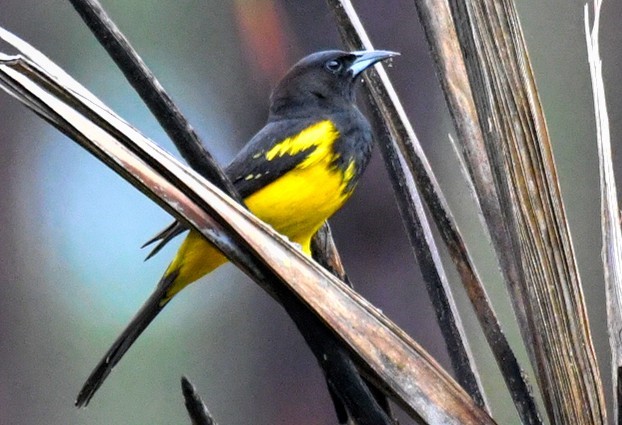Birdfinding.info ⇒ Critically endangered following a population crash in the late 1900s, but it remains fairly easy to find at several accessible locations on North Andros, including Nicholls Town, Owens Town, and Andros Town.
Bahama Oriole
Icterus northropi
Endemic to the northern Bahamas and now confined to the Andros archipelago: North Andros, Mangrove Cay, and South Andros. Disappeared from Abaco during the 1990s.
Occurs in wooded upland habitats: pine forest, coppice (dry deciduous forest), and lightly developed areas with palm trees for nesting.
IUCN classifies it as critically endangered, with brood parasitism by Shiny Cowbird considered most likely to be the primary factor in its decline. Surveys conducted in 2010 detected 127 individuals: 81 on North Andros, 22 on Mangrove Cay, and 24 on South Andros. The total population was likely somewhat larger, but believed to be less than 300.
Identification
A black-and-yellow oriole, unique in its tiny range. Adult has a black hood, back, wings, and tail; otherwise yellow, including the shoulders.
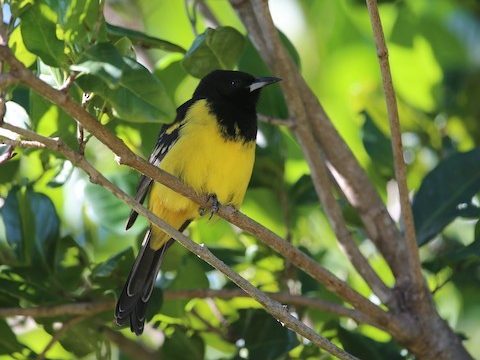
Bahama Oriole. (Nicholls Town, North Andros, Bahamas; January 4, 2018.) © Bert Harris

Bahama Oriole. (Mars Bay, South Andros, Bahamas; April 22, 2017.) © New Providence Bird Club
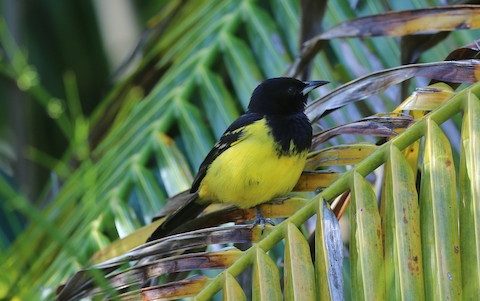
Bahama Oriole. (Nicholls Town, North Andros, Bahamas; January 4, 2018.) © Bert Harris
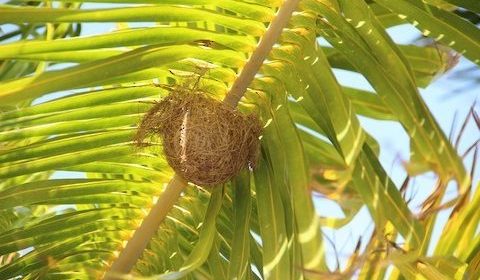
Bahama Oriole nest. (Mangrove Cay, Bahamas; June 2, 2017.) © Elijah Sands
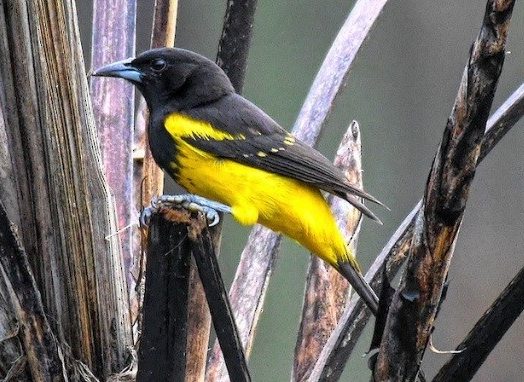
Bahama Oriole. (Owens Town, North Andros, Bahamas; March 11, 2018.) © Duncan Mullis
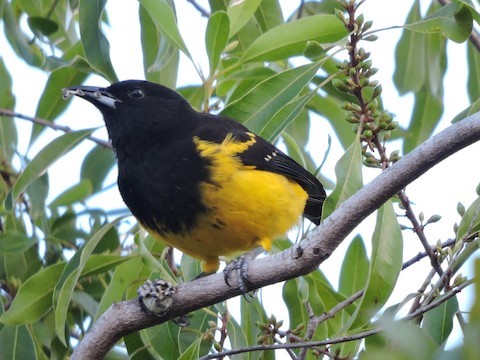
Bahama Oriole. (Andros Town, North Andros, Bahamas; April 28, 2018.) © Kathryn Cowdery

Bahama Oriole. (Man-O-War Sound, Central Andros, Bahamas; April 18, 2016.) © Erika Gates
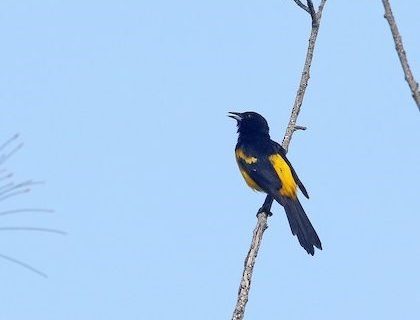
Bahama Oriole, showing yellow rump and lower back. (Small Hope Lodge, North Andros, Bahamas; May 21, 2016.) © Andrew Spencer

Bahama Oriole. (Stafford Creek Lodge, North Andros, Bahamas; March 19, 2018.) © Stuart White
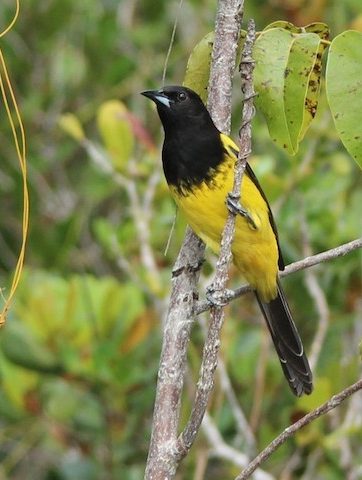
Bahama Oriole. (Stafford Creek Lodge, North Andros, Bahamas; March 19, 2018.) © Stuart White
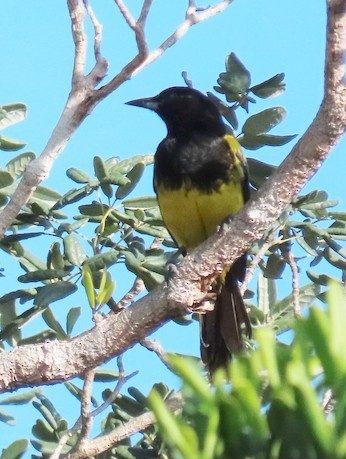
Bahama Oriole. (Owens Town, North Andros, Bahamas; February 28, 2019.) © Nancy Miller
Immature is dingy olive-yellow overall, with grayish-brown wings, back, and tail, and a whitish bar on the shoulder.

Bahama Oriole, immature. (Owens Town, North Andros, Bahamas; March 20, 2018.) © Stuart White
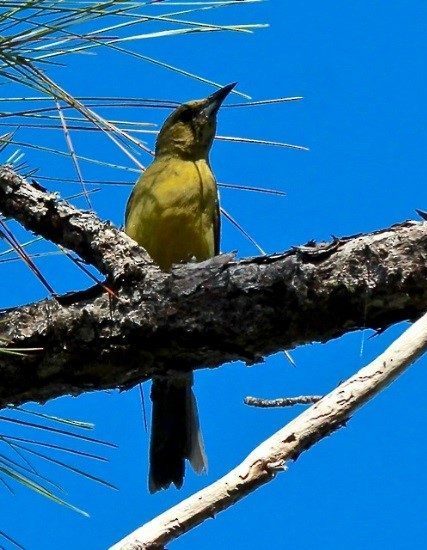
Bahama Oriole, immature. (Blue Holes National Park, North Andros, Bahamas; March 19, 2018.) © Stuart White
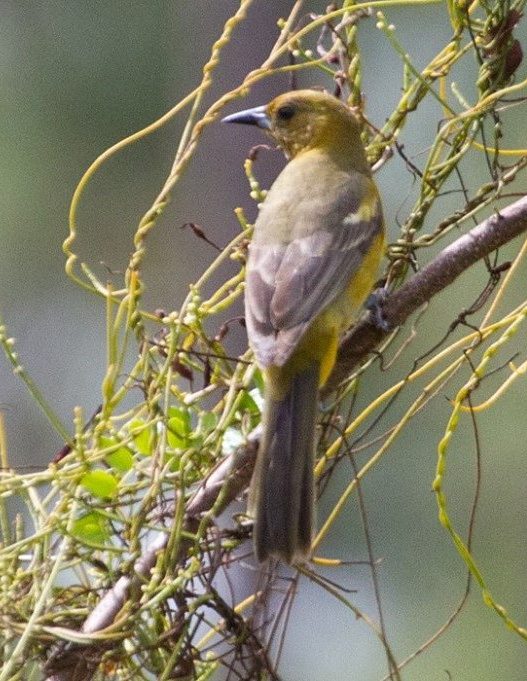
Bahama Oriole, immature, dorsal view. (North Andros, Bahamas; November 23, 2012.) © John H. Boyd III
Notes
Monotypic species.
Formerly considered conspecific with Cuban, Hispaniolan, and Puerto Rican Orioles, collectively known as the Greater Antillean Oriole (Icterus dominicensis). At other times, Greater Antillean was considered conspecific with the Black-cowled Oriole (Icterus prosthemelas) of Central America, collectively known as the Black-cowled Oriole (Icterus dominicensis). The basis for lumping all of these forms together was never strong. The adults are visually distinct and have different songs, and the immature and intermediate plumages are even more visually distinct.
Genetic studies have confirmed that most members of this group are more closely related to other species than they are to one another: the Central American Black-cowled is more closely related to Orchard Oriole; Puerto Rican is more closely related to the three Lesser Antillean orioles (Montserrat, Martinique, and St. Lucia); and Hispaniolan is most closely related to the combined Puerto Rican and Lesser Antillean group. Among the five species formerly lumped together as the “Black-cowled Oriole,” only Cuban and Bahama are a close phyletic pair, although ironically these are the most different from one another visually: Cuban being the blackest and Bahama the yellowest.
IUCN Red List Status: Critically Endangered.
References
BirdLife International. 2016. Icterus northropi. The IUCN Red List of Threatened Species 2016: e.T22736369A95132045. http://dx.doi.org/10.2305/IUCN.UK.2016-3.RLTS.T22736369A95132045.en. (Accessed May 19, 2019.)
eBird. 2019. eBird: An online database of bird distribution and abundance. Cornell Lab of Ornithology, Ithaca, N.Y. http://www.ebird.org. (Accessed May 19, 2019.)
Fraga, R., E. de Juana, and C.I. Sharpe. 2019. Bahama Oriole (Icterus northropi). In Handbook of the Birds of the World Alive (J. del Hoyo, A. Elliott, J. Sargatal, D.A. Christie, and E. de Juana, eds.). Lynx Edicions, Barcelona. https://www.hbw.com/node/62268. (Accessed May 19, 2019.)
Kane, M. 2017. Bahama Oriole (Icterus northropi), version 1.0. In Neotropical Birds Online (T.S. Schulenberg, ed.). Cornell Lab of Ornithology, Ithaca, N.Y. https://doi.org/10.2173/nb.graori3.01.
Jaramillo, A., and P. Burke. 1999. New World Blackbirds: The Icterids. Princeton University Press, Princeton, N.J.
Price, M.R., C. Person, and W.K. Hayes. 2015. Geographic variation and genetic structure in the Bahama Oriole (Icterus northropi), a critically endangered synanthropic species. PeerJ 3:e1421. https://doi.org/10.7717/peerj.1421.
Raffaele, H., J. Wiley, O. Garrido, A. Keith, and J. Raffaele. 1998. A Guide to the Birds of the West Indies. Princeton University Press, Princeton, N.J.
